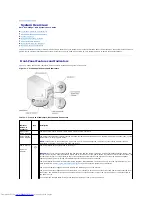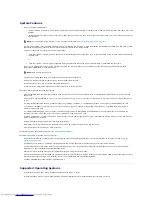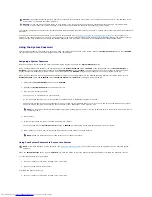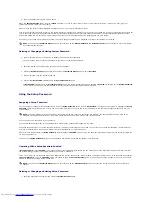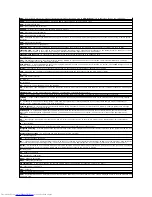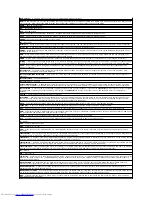
Back to Contents Page
Glossary
Dell™ PowerEdge™ 830 Systems User's Guide
This section defines or identifies technical terms, abbreviations, and acronyms used in your system documents.
A
—
Ampere(s).
AC
—
Alternating current.
ACPI
—
Advanced Configuration and Power Interface. A standard interface for enabling the operating system to direct configuration and power
management.
ambient temperature
—
The temperature of the area or room where the system is located.
ANSI
—
American National Standards Institute. The primary organization for developing technology standards in the U.S.
application
—
Software designed to help you perform a specific task or series of tasks. Applications run from the operating system.
ASCII
—
American Standard Code for Information Interchange.
asset tag
—
An individual code assigned to a system, usually by an administrator, for security or tracking purposes.
backup
—
A copy of a program or data file. As a precaution, back up your system's hard drive on a regular basis. Before making a change to the
configuration of your system, back up important start-up files from your operating system.
backup battery
—
A battery that maintains system configuration, date, and time information in a special section of memory when the system is turned off.
beep code
—
A diagnostic message in the form of a pattern of beeps from your system's speaker. For example, one beep, followed by a second beep, and
then a burst of three beeps is beep code 1-1-3.
BIOS
—
Basic input/output system. Your system's BIOS contains programs stored on a flash memory chip. The BIOS controls the following:
l
Communications between the processor and peripheral devices
l
Miscellaneous functions, such as system messages
bit
—
The smallest unit of information interpreted by your system.
blade
—
A module that contains a processor, memory, and a hard drive. The modules are mounted into a chassis that includes power supplies and fans.
BMC
—
Baseboard management controller.
boot routine
—
A program that clears all memory, initializes devices, and loads the operating system when you start your system. Unless the operating
system fails to respond, you can reboot (also called
warm boot
) your system by pressing <Ctrl><Alt><Del>. Otherwise, you must restart the system by
pressing the reset button or by turning the system off and then back on.
bootable diskette
—
A diskette that is used to start your system if the system will not boot from the hard drive.
BTU
—
British thermal unit.
bus
—
An information pathway between the components of a system. Your system contains an expansion bus that allows the processor to communicate
with controllers for the peripheral devices connected to the system. Your system also contains an address bus and a data bus for communications between
the processor and RAM.
C
—
Celsius.
cache
—
A fast storage area that keeps a copy of data or instructions for quick data retrieval. When a program makes a request to a disk drive for data that
is in the cache, the disk-cache utility can retrieve the data from RAM faster than from the disk drive.
CD
—
Compact disc. CD drives use optical technology to read data from CDs.
cm
—
Centimeter(s).
cmos
—
Complementary metal-oxide semiconductor.
component
—
As they relate to DMI, components include operating systems, computer systems, expansion cards, and peripherals that are compatible with
DMI. Each component is made up of groups and attributes that are defined as relevant to that component.
COM
n
—
The device names for the serial ports on your system.
control panel
—
The part of the system that contains indicators and controls, such as the power button and power indicator.
controller
—
A chip that controls the transfer of data between the processor and memory or between the processor and a peripheral.
conventional memory
—
The first 640 KB of RAM. Conventional memory is found in all systems. Unless they are specially designed, MS-DOS
®
programs are
limited to running in conventional memory.
coprocessor
—
A chip that relieves the system's processor of specific processing tasks. A math coprocessor, for example, handles numeric processing.
CPU
—
Central processing unit. See
processor
.
DC
—
Direct current.
DDR
—
Double-data rate. A technology in memory modules that potentially doubles the output.
device driver
—
A program that allows the operating system or some other program to interface correctly with a peripheral. Some device drivers
—
such as
network drivers
—
must be loaded from the
config.sys
file or as memory-resident programs (usually, from the
autoexec.bat
file). Others must load when you
start the program for which they were designed.
DHCP
—
Dynamic Host Configuration Protocol. A method of automatically assigning an IP address to a client system.
diagnostics
—
A comprehensive set of tests for your system.
DIMM
—
Dual in-line memory module. See also
memory module
.
DIN
—
Deutsche Industrie Norm
.
directory
—
Directories help keep related files organized on a disk in a hierarchical, "inverted tree" structure. Each disk has a "root" directory. Additional
directories that branch off the root directory are called
subdirectories
. Subdirectories may contain additional directories branching off them.
DMA
—
Direct memory access. A DMA channel allows certain types of data transfer between RAM and a device to bypass the processor.
DMI
—
Desktop Management Interface. DMI enables the management of your system's software and hardware by collecting information about the system's
components, such as the operating system, memory, peripherals, expansion cards, and asset tag.
Summary of Contents for PowerEdge 830
Page 4: ......
Page 20: ...Back to Contents Page ZIF Zero insertion force ...




